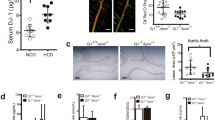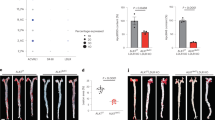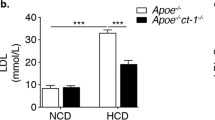Abstract
Interleukin-5 (IL-5) increases the secretion of natural T15/EO6 IgM antibodies that inhibit the uptake of oxidized low-density lipoprotein (LDL) by macrophages. This study aimed to determine whether macrophage-specific expression of IL-5 in LDL receptor-deficient mice (Ldlr−/−) could improve cholesterol metabolism and reduce atherosclerosis. To induce macrophage-specific IL-5 expression, the pLVCD68-IL5 lentivirus was delivered into Ldlr−/− mice via bone marrow transplantation. The recipient mice were fed a Western-type diet for 12 weeks to induce lesion formation. We found that IL-5 was efficiently and specifically overexpressed in macrophages in recipients of pLVCD68-IL5-transduced bone marrow cells (BMC). Plasma titers of T15/EO6 IgM antibodies were significantly elevated by 58% compared with control mice transplanted with pLVCD68 lacking the IL-5 coding sequence. Plaque areas of aortas in IL-5-overexpressing mice were reduced by 43% and associated with a 2.4-fold decrease in lesion size at the aortic roots when compared with mice receiving pLVCD68-transduced BMCs. The study showed that macrophage-specific overexpression of IL-5 inhibited the progression of atherosclerotic lesions. These findings suggest that modulation of IL-5 cytokine expression represents a potential strategy for intervention of familial hypercholesterolemia and other cardiovascular diseases.
This is a preview of subscription content, access via your institution
Access options
Subscribe to this journal
Receive 12 print issues and online access
$259.00 per year
only $21.58 per issue
Buy this article
- Purchase on Springer Link
- Instant access to full article PDF
Prices may be subject to local taxes which are calculated during checkout




Similar content being viewed by others
References
Sjouke B, Kusters DM, Kastelein JJ, Hovingh GK . Familial hypercholesterolemia: present and future management. Curr Cardiol Rep 2011; 13: 527–536.
Robinson JG . Management of familial hypercholesterolemia: a review of the recommendations from the National Lipid Association Expert Panel on Familial Hypercholesterolemia. J Manag Care Pharm 2013; 19: 139–149.
Kleemann R, Zadelaar S, Kooistra T . Cytokines and atherosclerosis: a comprehensive review of studies in mice. Cardiovasc Res 2008; 79: 360–376.
Sanderson CJ . Interleukin-5, eosinophils, and disease. Blood 1992; 79: 3101–3109.
Huang CD, Wang CH, Liu CY, Lin SM, Chou CL, Liu WT et al. Eosinophils from asthmatics release IL-5 in an autocrine fashion to prevent apoptosis through upregulation of Bcl-2 expression. J Asthma 2005; 42: 395–403.
Rosenwasser LJ, Rothenberg ME . IL-5 pathway inhibition in the treatment of asthma and Churg-Strauss syndrome. J Allergy Clin Immunol 2010; 125: 1245–1246.
Bossios A, Sjöstrand M, Dahlborn AK, Samitas K, Malmhäll C, Gaga M et al. IL-5 expression and release from human CD34 cells in vitro; ex vivo evidence from cases of asthma and Churg-Strauss syndrome. Allergy 2010; 65: 831–839.
Losol P, Kim SH, Hwang EK, Shin YS, Park HS . IL-5 promoter polymorphism enhances IgE responses to Staphylococcal superantigens in adult asthmatics. Allergy Asthma Immunol Res 2013; 5: 106–109.
Binder CJ, Hartvigsen K, Chang MK, Miller M, Broide D, Palinski W et al. IL-5 links adaptive and natural immunity specific for epitopes of oxidized LDL and protects from atherosclerosis. J Clin Invest 2004; 114: 427–437.
Palinski W, Hörkkö S, Miller E, Steinbrecher UP, Powell HC, Curtiss LK et al. Cloning of monoclonal autoantibodies to epitopes of oxidized lipoproteins from apolipoprotein E-deficient mice. Demonstration of epitopes of oxidized low density lipoprotein in human plasma. J Clin Invest 1996; 98: 800–814.
Shaw PX, Hörkkö S, Chang MK, Curtiss LK, Palinski W, Silverman GJ et al. Natural antibodies with the T15 idiotype may act in atherosclerosis, apoptotic clearance, and protective immunity. J Clin Invest 2000; 105: 1731–1740.
Sämpi M, Ukkola O, Päivänsalo M, Kesäniemi YA, Binder CJ, Hörkkö S . Plasma interleukin-5 levels are related to antibodies binding to oxidized low-density lipoprotein and to decreased subclinical atherosclerosis. J Am Coll Cardiol 2008; 52: 1370–1378.
Chen Y, Duan Y, Kang Y, Yang X, Jiang M, Zhang L et al. Activation of liver X receptor induces macrophage interleukin-5 expression. J Biol Chem 2012; 287: 43340–43350.
Frisdal E, Lesnik P, Olivier M, Robillard P, Chapman MJ, Huby T et al. Interleukin-6 protects human macrophages from cellular cholesterol accumulation and attenuates the proinflammatory response. J Biol Chem 2011; 286: 30926–30936.
Han X, Kitamoto S, Lian Q, Boisvert WA . Interleukin-10 facilitates both cholesterol uptake and efflux in macrophages. J Biol Chem 2009; 284: 32950–32958.
Huang S, Endo RI, Nemerow GR . Upregulation of integrins alpha v beta 3 and alpha v beta 5 on human monocytes and T lymphocytes facilitates adenovirus-mediated gene delivery. J Virol 1995; 69: 2257–2263.
Zeng L, Planelles V, Sui Z, Gartner S, Maggirwar SB, Dewhurst S et al. HIV-1-based defective lentiviral vectors efficiently transduce human monocytes-derived macrophages and suppress replication of wild-type HIV-1. J Gene Med 2006; 8: 18–28.
Leyva FJ, Anzinger JJ, McCoy Jr JP, Kruth HS . Evaluation of transduction efficiency in macrophage colony-stimulating factor differentiated human macrophages using HIV-1 based lentiviral vectors. BMC Biotechnol 2011; 11: 13.
Bobadilla S, Sunseri N, Landau NR . Efficient transduction of myeloid cells by an HIV-1-derived lentiviral vector that packages the Vpx accessory protein. Gene Ther 2013; 20: 514–520.
Tong J, Buch S, Yao H, Wu C, Tong HI, Wang Y et al. Monocytes-derived macrophages mediated stable expression of human brain-derived neurotrophic factor, a novel therapeutic strategy for neuro AIDS. PLoS One 2014; 9: e82030.
Gough PJ, Gordon S, Greaves DR . The use of human CD68 transcriptional regulatory sequences to direct high-level expression of class A scavenger receptor in macrophages in vitro and in vivo. Immunology 2001; 103: 351–361.
Lang R, Rutschman RL, Greaves DR, Murray PJ . Autocrine deactivation of macrophages in transgenic mice constitutively overexpressing IL-10 under control of the human CD68 promoter. J Immunol 2002; 168: 3402–3411.
Horvai A, Palinski W, Wu H, Moulton KS, Kalla K, Glass CK . Scavenger receptor A gene regulatory elements target gene expression to macrophages and to foam cells of atherosclerotic lesions. Proc Natl Acad Sci USA 1995; 92: 5391–5395.
Huber MC, Jägle U, Krüger G, Bonifer C . The developmental activation of the chicken lysozyme locus in transgenic mice requires the interaction of a subset of enhancer elements with the promoter. Nucleic Acids Res 1997; 25: 2992–3000.
Whitman SC, Rateri DL, Szilvassy SJ, Cornicelli JA, Daugherty A . Macrophage-specific expression of class A scavenger receptors in LDL receptor(−/−) mice decreases atherosclerosis and changes spleen morphology. J Lipid Res 2002; 43: 1201–1208.
Rani R, Smulian AG, Greaves DR, Hogan SP, Herbert DR . TGF-β limits IL-33 production and promotes the resolution of colitis through regulation of macrophage function. Eur J Immunol 2011; 41: 2000–2009.
Menghini R, Casagrande V, Menini S, Marino A, Marzano V, Hribal ML et al. TIMP3 overexpression in macrophages protects from insulin resistance, adipose inflammation, and nonalcoholic fatty liver disease in mice. Diabetes 2012; 61: 454–462.
Levin MC, Lidberg U, Jirholt P, Adiels M, Wramstedt A, Gustafsson K et al. Evaluation of macrophage-specific promoters using lentiviral delivery in mice. Gene Ther 2012; 19: 1041–1047.
He W, Qiang M, Ma W, Valente AJ, Quinones MP, Wang W et al. Development of a synthetic promoter for macrophage gene therapy. Hum Gene Ther 2006; 17: 949–959.
Kang WS, Kwon JS, Kim HB, Jeong HY, Kang HJ, Jeong MH et al. A macrophage-specific synthetic promoter for therapeutic application of adiponectin. Gene Ther 2014; 21: 353–362.
Gough PJ, Gomez IG, Wille PT, Raines EW . Macrophage expression of active MMP-9 induces acute plaque disruption in apoE-deficient mice. J Clin Invest 2006; 116: 59–69.
Han X, Kitamoto S, Wang H, Boisvert WA . Interleukin-10 overexpression in macrophages suppresses atherosclerosis in hyperlipidemic mice. FASEB J 2010; 24: 2869–2880.
Teupser D, Kretzschmar D, Tennert C, Burkhardt R, Wilfert W, Fengler D et al. Effect of macrophage overexpression of murine liver X receptor-alpha (LXR-alpha) on atherosclerosis in LDL-receptor deficient mice. Arterioscler Thromb Vasc Biol 2008; 28: 2009–2015.
Shen J, Herderick E, Cornhill JF, Zsigmond E, Kim HS, Kühn H et al. Macrophage-mediated 15-lipoxygenase expression protects against atherosclerosis development. J Clin Invest 1996; 98: 2201–2208.
Bonifer C, Vidal M, Grosveld F, Sippel AE . Tissue specific and position independent expression of the complete gene domain for chicken lysozyme in transgenic mice. EMBO J 1990; 9: 2843–2848.
Lasser EC, Berry C, Kortman K . Diminished atherosclerotic arterial calcifications in asthma. A possible role for elevated endogenous heparin-like material. Allergy 1987; 42: 549–552.
Wool GD, Cabana VG, Lukens J, Shaw PX, Binder CJ, Witztum JL et al. 4F Peptide reduces nascent atherosclerosis and induces natural antibody production in apolipoprotein E-null mice. FASEB J 2011; 25: 290–300.
Acknowledgements
This work was supported by the National Natural Science Foundation of China (Grant No. 81460277).
Author information
Authors and Affiliations
Corresponding author
Ethics declarations
Competing interests
The authors declare no conflict of interest.
Rights and permissions
About this article
Cite this article
Zhao, W., Lei, T., Li, H. et al. Macrophage-specific overexpression of interleukin-5 attenuates atherosclerosis in LDL receptor-deficient mice. Gene Ther 22, 645–652 (2015). https://doi.org/10.1038/gt.2015.33
Received:
Revised:
Accepted:
Published:
Issue Date:
DOI: https://doi.org/10.1038/gt.2015.33
This article is cited by
-
Molecular characterization of atherosclerosis in HIV positive persons
Scientific Reports (2021)
-
IL-13 may be involved in the development of CAD via different mechanisms under different conditions in a Chinese Han population
Scientific Reports (2018)



